Performance
Performance
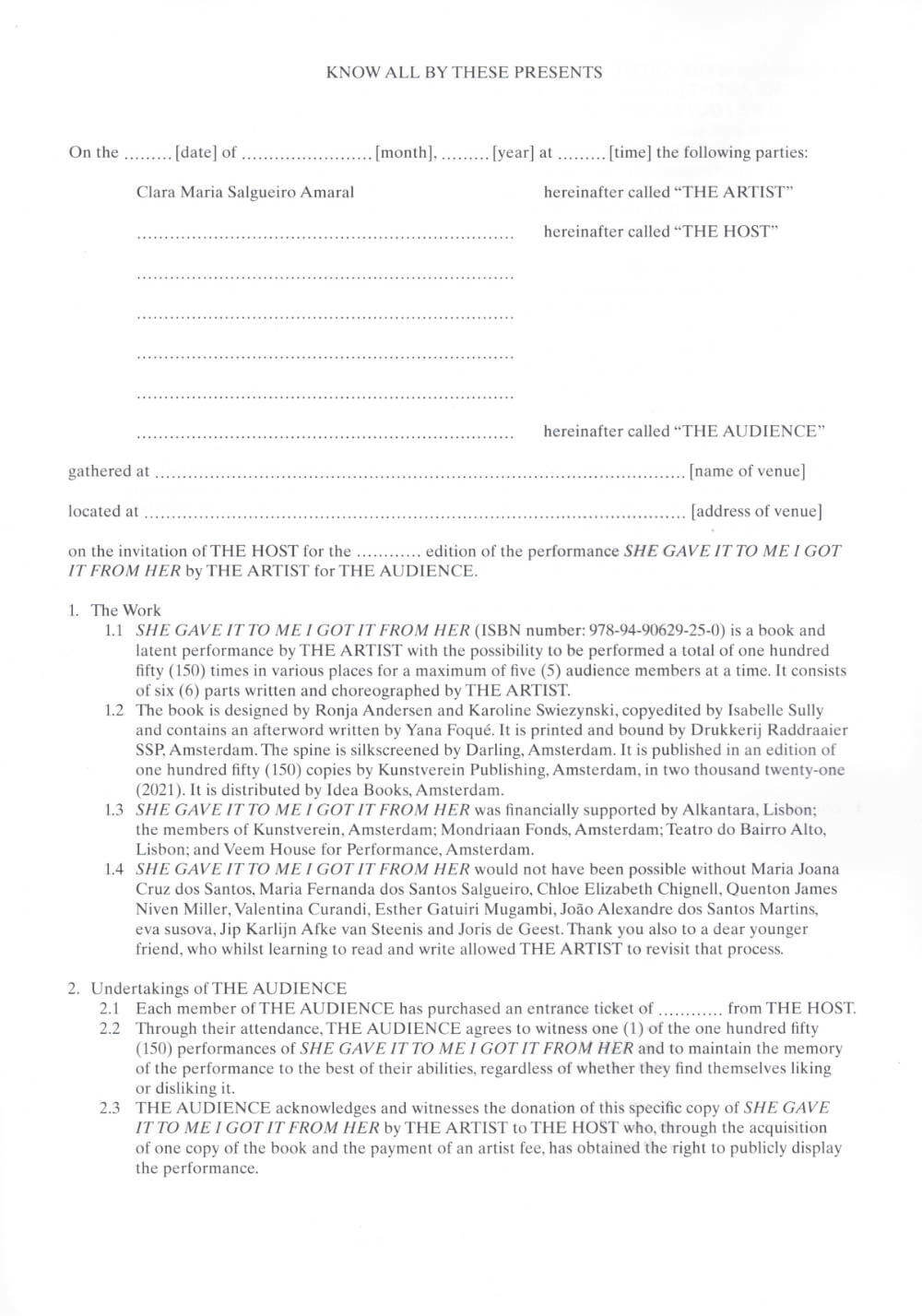
She Gave It To Me I Gave It To Her
She gave it to me I got it from her—a poem that choreographs her hands and voice—her voice that reads out loud the book—becoming script—becoming performance—becoming archive — the permanence of her voice in the book—in the book—the presence and absence of their names—She gave it to me I got it from her—It's a book and a choreography, read out loud and handled by a performer, for a group of people.
Clara Amaral is an artist working with text and performance. Her artistic practice is situated in an interdisciplinary perspective, questioning what it means to be a reader, to be a writer, aiming to expand existing modes of reading and writing. Central to her practice is the investigation of innovative publishing modalities and the performative aspect of writing and language through an intersectional feminist approach. www.misted.cc
Written and choreographed by Clara Amaral
Graphic Design Ronja Andersen and Karoline Swiezynski
Copy editor Isabelle Sully
Conceptualization and fabrication of objects Olga Micińska in dialogue with Clara Amaral
Published by Kunstverein Publishing

Reading Room: An Experiment in Expanded Reading
“Reading Room: meeting the universe halfway is a book – a collection of five booklets – that came out of a multi-sensory project created by Harriet Plewis that attempted to make sense of a key text by theoretical physicist and feminist theorist Karen Barad.
The volume contains a booklet describing the ideas, experiments and practices of expanded reading in reference to Barad’s text, and the remaining four booklets are workbooks, or manuals, to help people replicate or expand on the ideas themselves. The books were produced by the artist in collaboration with Sam Whetton and Chery Styles.”
5x A5 booklets, All black & white digitally printed, 4x saddle stitched 1x perfect bound. Comes sandwiched between embossed card.
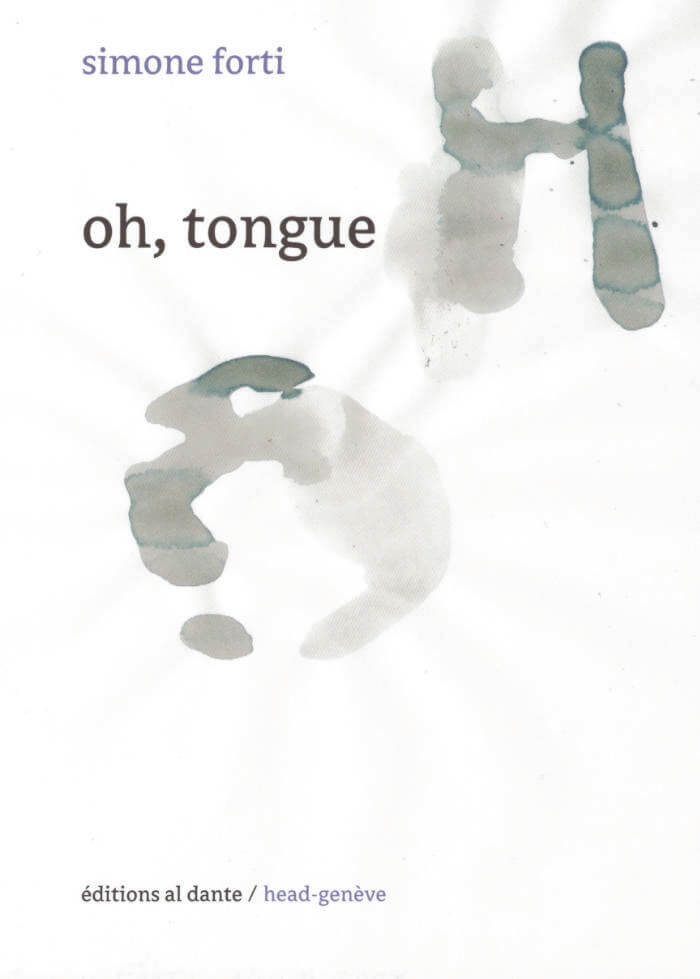
oh, tongue
The notebook of American dancer and choreographer Simone Forti, in which she shares her poetry as well as her thoughts on dance, the body, writing, the state of the world… The publication includes an interview with Forti by Annie Suquet, and an afterword by poet and Fluxus artist Jakson Mac Low.
American dancer and choreographer Simone Forti (born 1935 in Florence, Italy) has been a leading figure in the development of contemporary performance over more than fifty years. Artist, choreographer, dancer, writer, Forti has dedicated herself to the research of a kinesthetic awareness, always engaging with experimentation and improvisation. Investigating the relationship between object and body, through animal studies, news animations and land portraits, she reconfigured the concept of performance and dance.
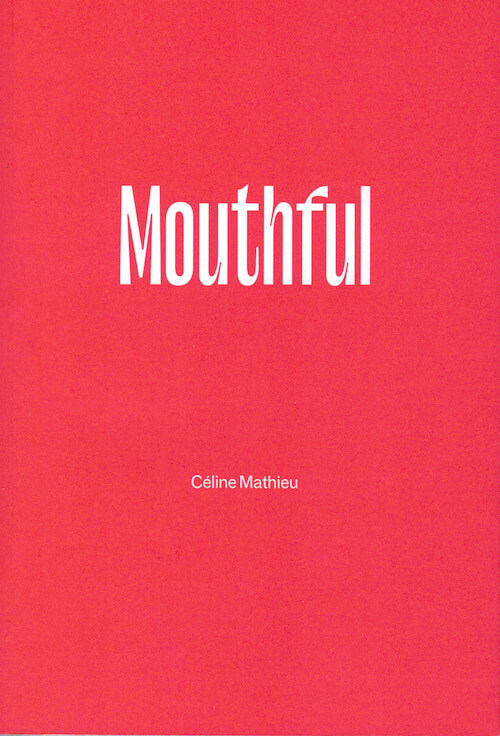
Mouthful
"She has fallen forward again, resting there like a reptile basking in the January sun. Where she was, in her corner, temperatures rose up to 28 degrees Celsuis. Her dry skin darkened, drinking the light."
In 2020, CMMC –Céline Mathieu and Myrthe van der Mark– were invited by organisers NICC Lodgers to perform at M HKA in Antwerp in response to art subsidy cuts in Flanders. Their contribution, The Writing Performance, was an attempt to write a novella each in three days, during the museum’s opening hours and in full sight of visitors. Throughout The Writing Performance, CMMC subsisted on water and sugar.
Published 2021.
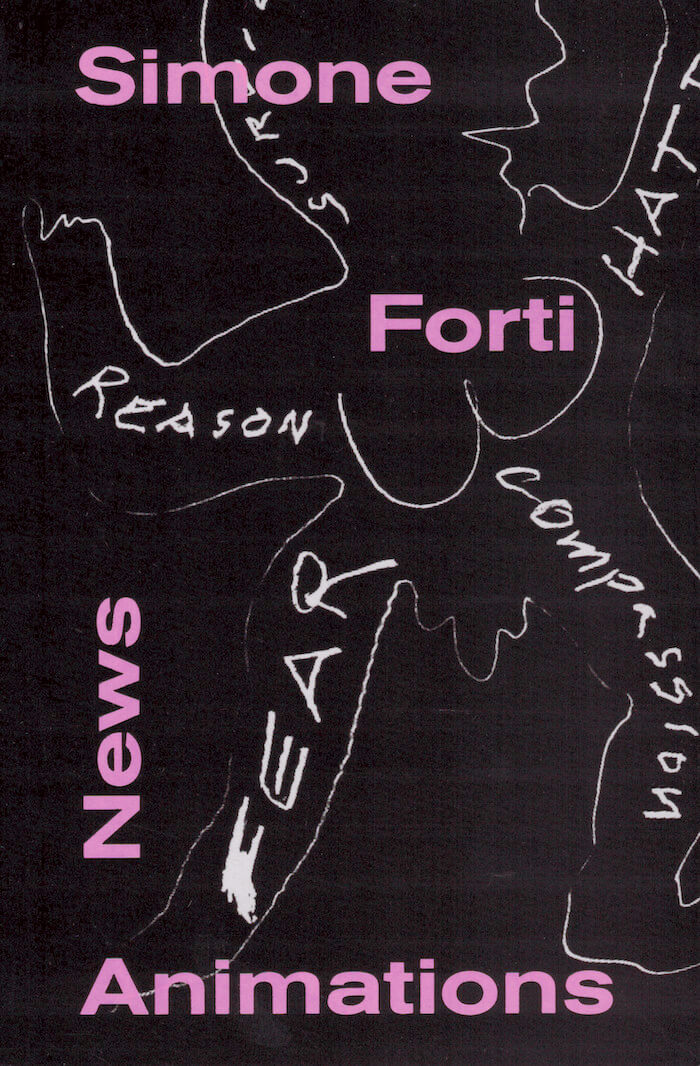
News Animations
A reference book containing all the transcripts of Simone Forti's News Animations.
The book is the complete collection of Simone Forti's News Animations, one of the works that best reveal her artistic practice. The news and, more broadly, the most pressing issues of the global socio-political situation, are used to explore the potential of language, its dimensions, and its combination with dance, movements, words, images, and music. Simone Forti has always "danced" the news, it's the way she tells them. But, above all, it's the way she internalizes them, feels them, and processes them. Through a stream of consciousness, the artist grants voice and body to thoughts about the world, its conflicts, war, injustices, and inequalities.
The volume collects Simone Forti's News Animations from 1980 to 2018—through the transcriptions of the performances, images, and drawings—seeking to capture their spirit, their poetic stance and, mostly, understand how they manage to describe the society and the world we live in.
Introduction by Luca Lo Pinto
Published August 2021
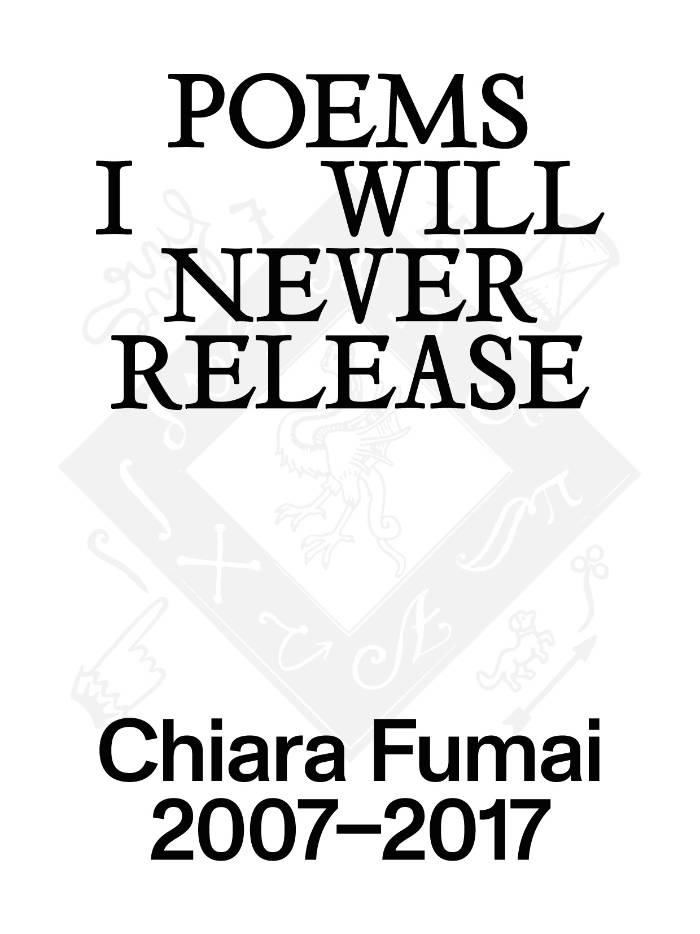
Poems I Will Never Release, 2007-2017
First retrospective monograph: an essential resource for any in-depth critical study of Chiara Fumai's work and thought, including a first systematic analysis of her oeuvre.
This book is dedicated to the complex artistic trajectory of Chiara Fumai, who played a significant role in the development of performance and feminist aesthetics in the twenty-first century and who died prematurely in 2017, at the age of only thirty-nine. Conceived as a critical monograph on Fumai's work as a visual artist, performer, DJ and music curator, Poems I Will Never Release is the first volume to trace the entirety of her artistic path: from her scathing video performances and large-scale installations, to her more intimist practices of automatic writing and collage and her incursions into music.
Almost 500 pages long, the volume is divided into three main chapters. The first of these brings together essays by prominent writers, curators and artists who examine Chiara Fumai's work from various perspectives, highlighting its intersections with anarchism, feminism, ideological forms and discourses of power and oppression, the animal rights movement, theater, surrealism and esotericism. The second chapter presents an imposing iconographic apparatus that documents Chiara Fumai's entire artistic production, from 2007 to 2017, while the third offers an exhaustively detailed chronology and bibliography.
The book collects essays by Irene Aristizábal, Andrea Bellini, Federico Campagna, Milovan Farronato, Francesco Urbano Ragazzi, Mara Montanaro, Chus Martínez, Paulina Olowska and Giovanna Zapperi, as well as conversations between Raimundas Malašauskas and Gabriel Lester, and Cristiana Perrella and Marcello Bellan. The chronology and bibliography are edited by Sara de Chiara.

“If It's For The People, It Needs To Be Beautiful,” She Said
Accompanying a series of solo collaborations in 2020, this publication offers the first comprehensive and global perspective on Jeremiah Day's work as an artist, performer, researcher and teacher. As it details Day's specific works and evolution between visual and performing arts and between political reflection and engagement the result also serves as sourcebook for the legacy of the intersection between dance and the visual arts of the 1960s and 70's and the models of cultural practice emerging from the work of Hannah Arendt.
In his work, the Berlin-based American artist Jeremiah Day (born 1974 in Plymouth) re-examines recent political struggles and conflicts, revealing their subjective contexts and traces. To do this, he has developed a narrative and choreographic form in which personal and political realities intermingle, thus offering a thoroughly singular vision of these at times forgotten moments of history.
The distinctive feature of his method lies in a transversal approach. As a student of and regular collaborator with Simone Forti, one of the pioneers of Post-Modern Dance, he has turned performance into a now central and structure-providing practice. Since 2014, Jeremiah Day has in effect presented many performances, which contain movement, improvisation, photography and the spoken word, in order to broach universal historical and political subjects, but within an intimate and incarnated context.

Intourism
INTOURISM is the space of organised concentration, playing a story about how a man who has no identification documents travels the world. how he was banned from entering a country for life. how he’s got no clue what to do with that and then how he remembers nothing about it. it’s a tale of adventure, anything and everything he runs into during his travels. of course it’s meditative manipulation and a question of feeling; activation of inner civilisation by passion, by calming down or by nothing at all. the altering of text into a metaphor that defines man.
The play is published as two books, one in Estonian and one in English.
kadrinoormets: in december last year peeter rästas came to me with a proposal. the same evening I accepted it – we did not marry. I love rästas but not necessarily theatre – the same night I began to write, I prepared – the text ended up being dedicated to rästas. six months later I gave him a text set of a hundred to read and get to know – rästas wasn’t too excited about it, but I certainly was. rästas seemed sceptical, he approached it with the thespian distrust of abstract (body-)patterns within the formula of stagetext; in terms of understanding, of course. that distrust suited me, scepticism as sweet starting potential – I knew that it would pass – rästas hasn’t stopped.
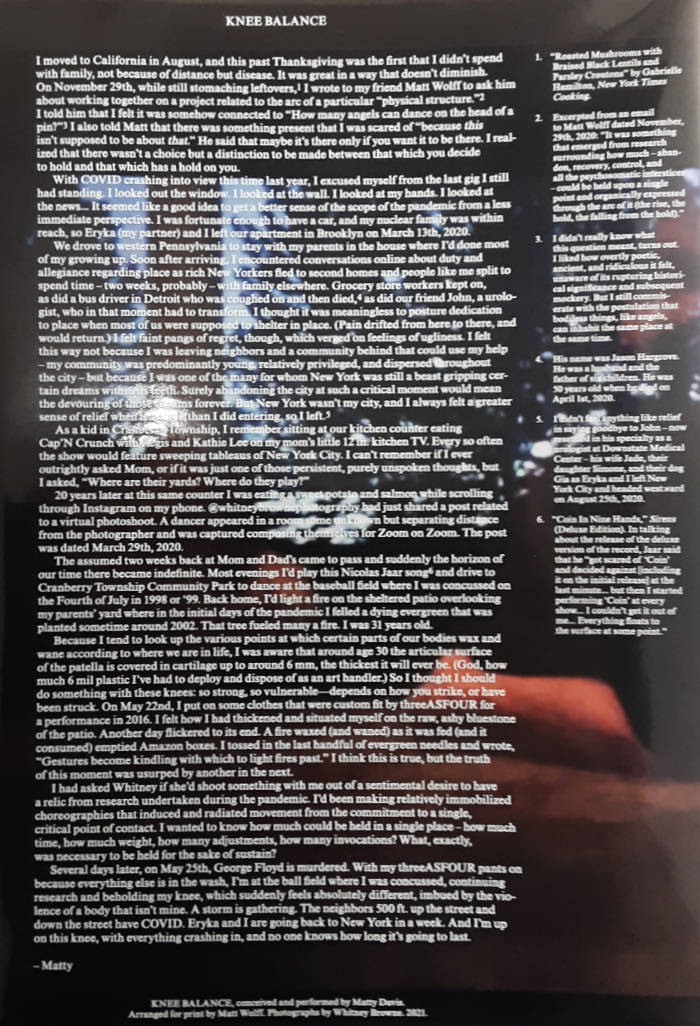
Knee Balance
KNEE BALANCE (2021) is a performance that uses choreography, writing, photography, and design to traverse particular anatomical, personal, and sociopolitical arcs. Time oscillates and fractures movement. Space unfolds. Situated before a hearth in the throes of balance, the performer becomes a crucible for memory, durability, and the reciprocal relationship between the present and the unforeseen.
Comes nested inside ad hoc polyvinyl sleeve with text by Matty Davis printed on front
This work marks the first in a series of performances by Matty Davis arranged for print by Matt Wolff. Distinct in content and form, each work weaves psychosomatic realities with the spatial and temporal possibilities of print.
Vital contributions have been made to this series of performances by artists including Will Arbery, Whitney Browne, Mark Davis, Eryka Dellenbach, Nile Harris, Jonah Rosenberg, Holly Sass, Matt Shalzi, and Bobbi Jene Smith.

I'm Not Sad, The World Is Sad
I'm Not Sad, The World Is Sad is an autotheoretical, semi-fictional account of a performance artist who lands a part-time job as an Embedded Artistic Researcher in an art institution. Invested in queer theory and institutional critique, she sets out to perform the artist 'differently' through a process of negation and passivity, inadvertently causing her relationship with the insitution's curator to grow increasingly speculative and paranoid. Louwerens dresses her protagonist in the different professional guises of artistic labour. Het experiences as tour guide, security guard, artist, hostess and researcher at different institutions begin to overlap and blend under the name of 'performance'.
I'm Not Sad, The World Is Sad is a fragmented story of paranoid and reparative reading, script and utterance, exposure and vulnerability.

Lilith, Losing, Lavender
Lilith, Losing, Lavender: A love letter to love, is a publication based on stretching the subjectivities in love from the formulation I love You, as a way of seeing what is under the gaze of western romantic ideas and heteropatriarchal structures that may reveal problems in language about love.
It gathers a collection of texts written throughout the artistic research trajectory of Andrea Zavala Folache. With different narrative styles as diary, love letters, score instructions, this collection imbricates ideas of love, art and life as an essay about conditions of attachment.
In the interstice of several practices as dance, writing and drawing and different spaces as the dance studio, the atelier, the classroom, the theatre and the white cube, Andrea’s research focuses on non chronological dramaturgies for the emergence of surprise or unexpectedness.
Published 2021.

I am Welton Santos.
I am Welton Santos reenacts a dialogue between the Brazilian geo-bio-architect Welton Santos and an Interviewer. The book, which is always read collectively, is used in reading performances by groups of at least 3 people.
Printed on the occasion of an artist residency at PAV, Parco d’Arte Vivente, Turin, July 2016. Texts based on transcripts of interviews with Welton Santos.

Yvonne Rainer Work 1961-73
It goes without saying that a dance is a dance and a book about dance is a book. Though they may meet at the intersection of Art and Good Intentions, I find myself greedy. I have a longstanding infatuation with language, a not-easily assailed conviction that it, above all else, offers a key to clarity. Not that it can replace experience, but rather holds a mirror to our experience, gives us distance when we need it. So here I am, in a sense, trying to 'replace' my performances with a book, greedily pushing language to clarify what already was clear in other terms. But, alas, gone. This has seemed one good reason to compile a book out of the remains of my performances, letting the language fall where it may. Let it be said 'She usually makes performances and has also made a book.' -Yvonne Rainer
Forty-five years after its publication, Primary Information brings Yvonne Rainer's classic book back into print in an exact facsimile.
In 1974, Yvonne Rainer published Work 1961-73, an illustrated catalog of her performance works up to that point. In these years, as the art world turned toward minimalism, Rainer and her Judson Dance Theater colleagues were engaged in a parallel, and equally radical, redefinition of dance. Stripping dance of its pomp and self-serious virtuosity, they created what dancer and choreographer Pat Catterson has called "the people's dance." Or, as Rainer put it, instead of the "overblown plot" of traditional dance, she explored the "obvious" alternative: "stand, walk, run, eat, carry bricks, show movies, or move and be moved by some thing other than oneself."
Work 1961-73 chronicles the years when Rainer found herself and her work at the heart of a revolution in dance, performance and art. Written in Rainer's wonderful frank, funny and perceptive prose, and illustrated with photographs, handwritten scores, sketches, press articles and ephemera, Work 1961-73 is a period document and an instruction manual, an archive and a manifesto.
A sought-after, rare classic, Work 1961-73 is brought back into print in a true facsimile edition by Primary Information; the only change is the small addition of new notes at the back of the book.
One of the most influential artists of her generation, dancer, choreographer and filmmaker Yvonne Rainer (born 1934) was a founding member of Judson Dance Theater in New York City and a leading figure in the development of minimalist and postmodern dance.

Adrian Piper: Performing Objects I have Been
Adrian Piper: Performing Objects I Have Been, 1972-2018, is a collection of documents from, or potentially relevant to Adrian Piper's performance Some Reflective Surfaces (1975-76) that has been edited by art historian and curator Rhea Anastas. This publication sits within If I Can't Dance, I Don't Want To Be Part Of Your Revolution's Peformance in Residence Series, and its seventh artistic program, Social Movement (2017-18).
Adrian Piper, who lives in Berlin, at the age of seventy-two, is one of America's best-known artists. It so happens she is also one of America's best-known female artists. And yet, to use such a qualifier is to make the mistake of accepting limitations, coerced and containing, for artists and thier work— and, to quote Jacqueline Rose, "to dissolve the very possibility for women of any purchase on historical time."
This publication focuses on an early performance called Some Reflective Surfaces (1975-76). In it, as Piper dances under spotlights, she stages multiple images and sounds. Over the work's duration, the audience follows the performer's images, physical performance, and sound. In "Artist's Statement" (1999), Piper descrvibes her 1960's work that led up to this one as "concered with duration, repetition, and meditative conciousness of the indexical present." Some Reflective Surfaces was produced in New York at the Fine Arts Building, New York University, in 1975, and then at the Whitney Museum of American Art in 1976. The performance has not been staged since. A collection of the documents of Some Reflective Surfaces is reissued in this publication for the first time, along with other writings spanning Piper's work from 1972-2018.
Published 2021.
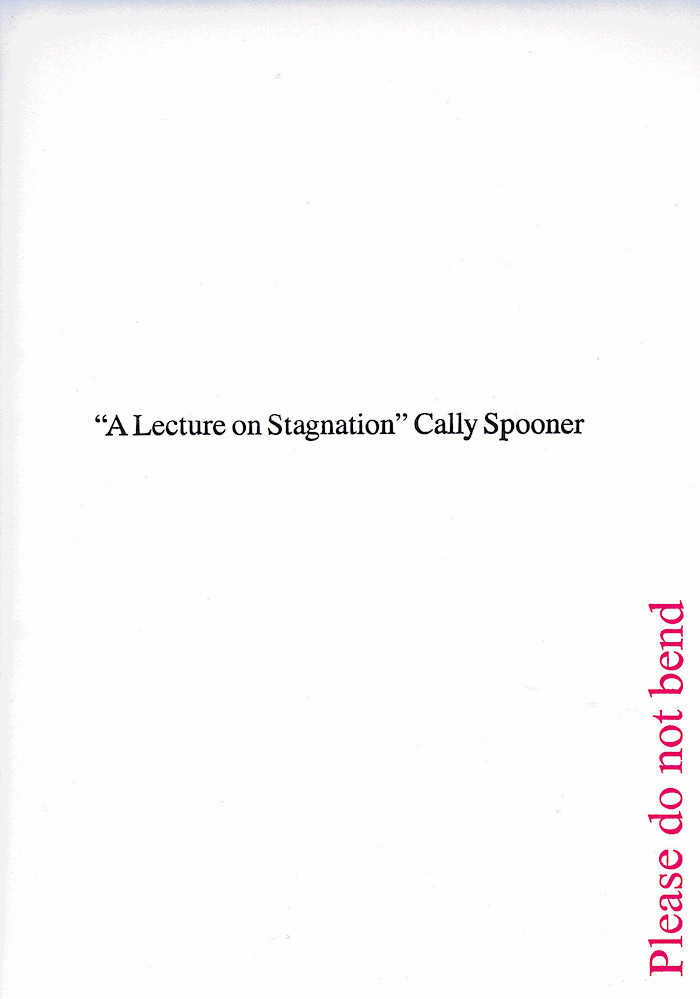
"A Lecture on Stagnation"
It is less a lecture, more like a cartography.
Parts may or may not sync up, we will see.
Ce qui suit est “Une conférence sur la stagnation”
Il s’agit moins d’une conférence que d’une
cartographie. Ses parties peuvent ou non
se synchroniser, nous verrons bien.
Dit is “Een lezing over stagnatie.”
Het is minder een lezing, dan een cartografie.
De onderdelen hiervan kunnen wel of niet
synchroon lopen, we zullen zien.
Trilingual (!) edition. Loose sheets in an envelope. On the same model as Resistance.

Monster Writing
Estefanía Álvarez Ramírez, Keren Kraizer
Project developed in conversation with Mette Edvardsen.
Design by Maria Camila Alfonso.
Published 2020.
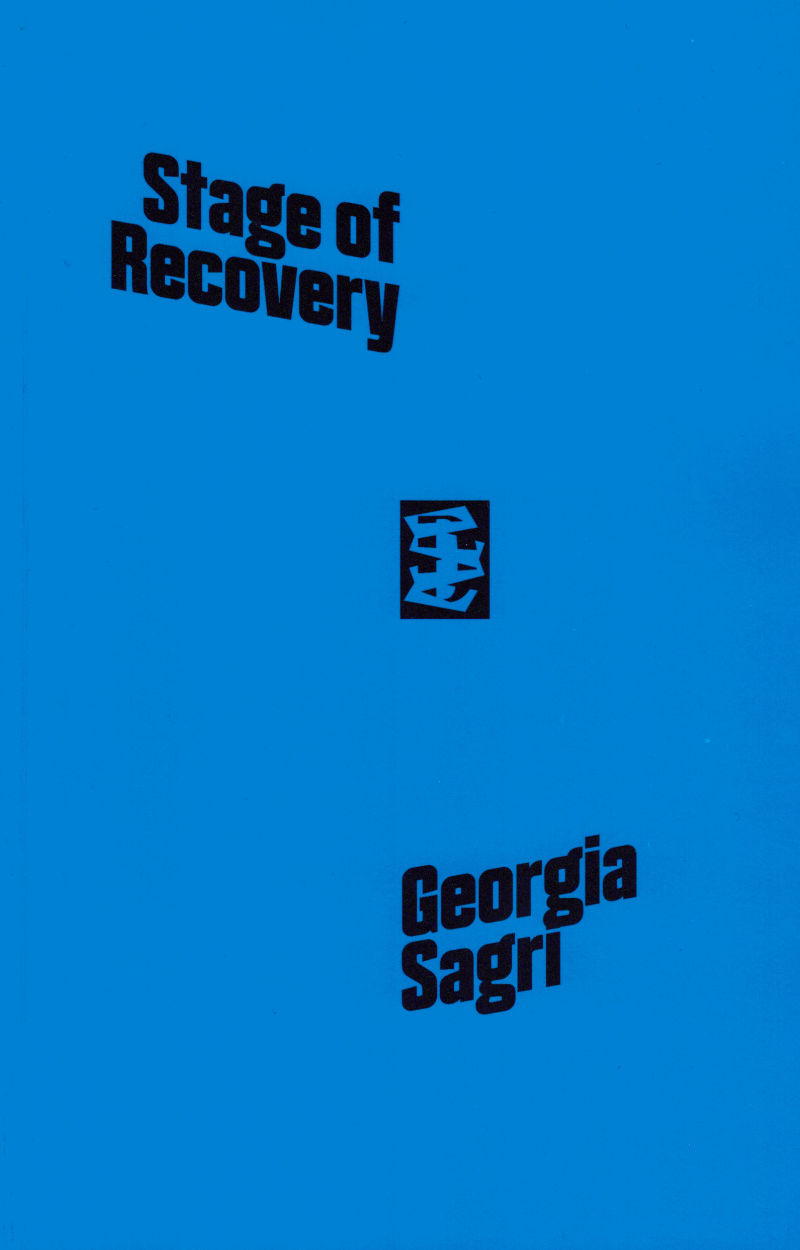
Stage of Recovery
Close to spiritual anarchism, Georgia Sagri’s writing happens in the heat of negotiation. Starting in the months leading up to the occupation of Zuccotti Park in 2011, which became the movement for people’s self-governance known as Occupy, this book carries the energy and commitment of open struggle, direct address, self-organisation and public assembly. It is a critique of representation and its implicit oblivion, told through a decade of artistic and activist practice. The writing is a mode of recovery, it is pre-content shared to encourage open processes in art, thinking and action.
Georgia Sagri (born Athens, 1979) lives and works in Athens and New York. Her practice is influenced by her ongoing engagement in political movements and struggles on issues of autonomy, empowerment and self-organisation. From 1997 to 2001 she was a member of Void Network, a cultural, political and philosophical collective operating in Athens. In 2011 she was one of the main organisers of the Occupy Wall Street movement in New York. Since 2013 she has been a member of the assembly of the Embros Theatre Occupation, and in 2014 she initiated Ύλη[matter]HYLE, a semi-public cultural space in the heart of Athens. She is professor of performance at the Athens School of Fine Arts.

Delta — An Ocean Call
Pontus Pettersson, Izabella Borzecka
Delta is a coming together for choreographic and performative work to be shared and exercised, a place for sharing work by doing the work. A container for participatory projects, dancing, exchange and choreographic inquiries. Delta is organised as evening dance classes, artist zines and thematic publications, like this one: On water histories, narratives and practices.
Water both divides and merges, varies and manifests in different kinds of shapes and structures, acquiring different relations with its surroundings. As a transformative material, could one say that water has a different kind of logic, another kind of dance? In this publication, the contributors Bronwyn Bailey-Charteris, Paul Maheke, Axel Andersson, Sindri Runudde, Vibeke Hermanrud, Elly Vadseth, Daniela Bershan, Sabrina Seifried, D.N.A. (Dina El Kaisy Friemuth, Neda Sanai and Anita Beikpour), Every Ocean Hughes, Adham Hafez, Pontus Pettersson, and Alice MacKenzie share their multi-layered practices, writings, memories and scores on water. Inviting you to submerge!
With contributions by: Bronwyn Bailey-Charteris, Paul Maheke, Axel Andersson, Sindri Runudde, Vibeke Hermanrud, Elly Vadseth, Daniela Bershan, Sabrina Seifried, D.N.A. (Dina El Kaisy Friemuth, Neda Sanai and Anita Beikpour), Every Ocean Hughes, Adham Hafez, Pontus Pettersson and Alice MacKenzie.
Bronwyn Bailey-Charteris: First Move, Original Rains: a Score for Sensing the Precipitational
Pontus Pettersson: Dripping from my fingertips
Adham Hafez: To dance about nature?
Daniela Bershan in collaboration with Sabrina Seifried: Mapping OCEAN
Sindri Runudde: Chosen by the barnacles
Vibeke Hermanrud in conversation with Elly Vadseth: Submerged
Axel Andersson: Confessions of a swimmer
D.N.A: Hydrocapsules.love
Paul Mahek:e As the Waters Recall
Alice MacKenzie: I know that smell
Every Ocean Hughes: Ocean
Pontus Pettersson: 100 ways of water
Graphic design by Sara Kaaman

Michael Clark: Cosmic Dancer
Hailed as British dance's true iconoclast, Michael Clark is a defining cultural figure in the contemporary dance world. Since emerging in the early 1980s as a prodigy at London's Royal Ballet School, Clark has remained at the forefront of innovation in dance, working in close collaboration with a broad range of pioneering artists such as Sarah Lucas, Leigh Bowery, Charles Atlas, Cerith Wyn Evans, Peter Doig, Elizabeth Peyton, Wolfgang Tillmans and musicians such as Mark E. Smith, Wire, Scritti Politti, and Relaxed Muscle.
As a young choreographer, Clark brought together his classical ballet training with London's club culture, fashion, and punk rock to establish himself as one of the most innovative artists working in modern dance. His work, variously referencing punk, rock, and pop—is marked by a mixture of technical rigor and experimentation in a way that disrupts and reimagines our understanding of dance.
This book features a series of enlightening essays and vivid illustrations of Clark's best-known performances, alongside archival material. Loosely tracing the chronological evolution of his career, a variety of cultural figures, ranging from Jarvis Cocker to Charles Atlas, write about the countercultural undercurrents with which Clark's work connects.

Yes, But Is It Edible?
Robert Ashley, Alex Waterman and 1 more
Some years ago, Will Holder and Alex Waterman proposed to Robert Ashley that musicians and non-musicians might produce new versions of his operas, by way of typographical scores. The bulk ofYes, But Is It Edible? is a result of that proposal: scores for Dust (1998) and Celestial Excursions (2003). These operas’ characters have, until now, been solely produced by and are the stories exchanged between Ashley and his “band” (singers Sam Ashley, Joan La Barbara, Thomas Buckner, and Jacqueline Humbert); and in landscapes produced by “Blue” Gene Tyranny, Tom Hamilton, David Moodey, Cas Boumans, and Mimi Johnson—the result of a thirty-year relationship.
The scores for Dust and Celestial Excursions are preceded by a selection of Ashley’s work, from 1963 to 2008, drawing attention to the varying relations between instruction and score, and the tones of instructional address. Working with these scores gave us a better sense of how each one produces a specific mode of decision-making, telling us what to put on the pages of the scores, for any reader who follows.
Yes, But Is It Edible? is the fourth in a series of publications produced with or by Will Holder and Alex Waterman that a musicological perspective on scoring speech, and the role of printed matter in collective forms of reading and writing: Agape (Miguel Abreu Gallery, 2007); Between Thought and Sound (The Kitchen, 2008); and The Tiger’s Mind (with Beatrice Gibson; Sternberg Press, 2012).

to discover a fossil on your tibia: scories and other mutations of scores
'To discover a fossil on your tibia: scories and other mutations of scores' is a collection of texts exploring the score as a choreographic tool for writing.
Magdalena Ptasznik, worked on several scores to introduce, instigate, and reflect upon the network of relations with other- than- human existences. She approaches choreography as a generative practice to speculate about future fictions for a world in environmental crisis. By using somatic practices, site-specific materials, storytelling in workshop settings, Magda seeks to empower change through activating collective imaginaries with the audience. For her End Presentation, a publication will be launched with a collection of writings that circulate around the idea of the score as a form of activating self-choreographic agencies.
Magdalena Ptasznik has been exploring choreography and dance through creating performances, dancing in the work of other makers, creating choreography for drama theater, and teaching. Through the last years, she focused on contexts of practice that turn towards creating shared spaces and experiences – teaching, collaborating, and creating performances for the limited public.

The Films of Yvonne Rainer
The scripts of Rainer's five films, presented here along with essays, an interview, and bibliography, demonstrate the evolution of her political consciousness as well as her creative engagement with the contemporary film and cultural scene. These texts challenge the illusionist and ideological presumptions of mainstream culture and cinema.
Film Scripts included:
Lives of Performers
Film About a Woman Who...
Kristina Talking Pictures
Journeys from Berlin/1971
The Man Who Envied Women

Jupiter: Andreas Sell ‘Life Performance’
Jupiter is the monograph of the artist Andreas Sell by the curator Joel Mu and the outcome of their collaboration. It includes a selection of Andreas’ work of the last fifteen years, an essay in five parts by Joel and a poem by Alice Heyward. Andreas’ work often coincides with his life story, composing both a material and immaterial narration. Joel shares biographical and autobiographical stories in his writing about Andreas’ work. The narratives intertwine.
Personal experiences, memories and relationships take shape with matter, images and words trying to make sense of the world—its social conditions and politics, other people and life itself.
Jupiter is about Andreas Sell’s ‘Life Performance’ as the title of the book suggests; it explores life performance from the constant position of a foreigner, from a viewpoint on the side. Andreas and Joel reflect on identities and challenge categorization; they seek for a more inclusive sense of belonging and defend the multiplicity of oneness. Jupiter also defies categorization; it is a monograph, but also a biography, an autobiography, a catalogue, an artist book, a diary, a collective work on one person’s work. — Text by Galini Noti

The Odd Years
Every Monday in 2017 and 2019, comedic performance artist Morgan Bassichis created a to-do list. THE ODD YEARS is a collection of those lists, which served both as a way to generate material for live performances and as a place to archive the logistical, emotional, and political business that just kept piling up throughout this two-year project. A record of routine and impossible tasks—some completed and others left unfinished—THE ODD YEARS is one response to the oddness of times in which intensified crisis becomes ordinary.
THE ODD YEARS is the fourth title in the Document Series, an interdisciplinary publishing initiative that highlights work by time-based artists in printed form.
Morgan Bassichis is a comedian and musician living in New York City. Morgan's performances include Nibbling the Hand that Feeds Me (Whitney Museum, New York 2019), Klezmer for Beginners (Abrons Arts Center, New York, 2019), More Protest Songs (Danspace Project, New York, 2018), and The Faggots & Their Friends Between Revolutions: The Musical (New Museum, New York, 2017).